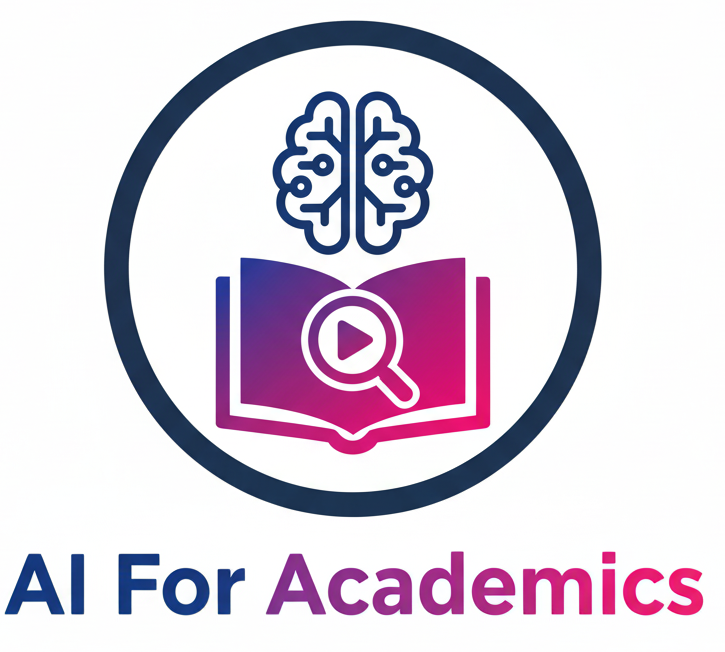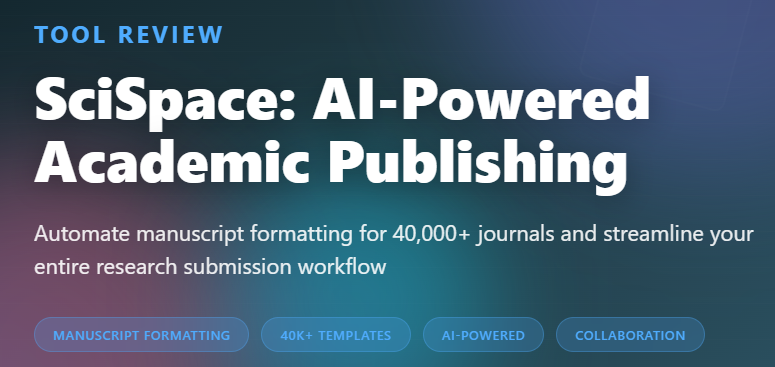The academic publishing process is notoriously time-consuming, with researchers spending countless hours formatting manuscripts, ensuring compliance with journal guidelines, and preparing submissions. SciSpace (formerly Typeset) emerges as a game-changing AI tool for academic publishing, designed to automate these tedious tasks and help scholars get their work published faster. In this comprehensive review, we’ll explore how SciSpace revolutionizes manuscript preparation and whether it’s the right tool for your research workflow.
What is SciSpace?
SciSpace is an AI-powered academic publishing platform that helps researchers format manuscripts to fit various journal templates, streamline the submission process, and ensure compliance with publishing standards. With access to over 40,000 journal templates, SciSpace eliminates the formatting headaches that plague academic authors, allowing them to focus on their research rather than wrestling with citation styles and margin requirements.
Originally launched as Typeset in 2018, the platform rebranded to SciSpace in 2022, expanding its capabilities beyond simple formatting to include literature review tools, AI-powered reading assistance, and collaborative writing features.
Key Features of SciSpace
1. Automated Manuscript Formatting
The cornerstone of SciSpace is its automatic formatting engine. Simply upload your manuscript in Word, LaTeX, or other formats, select your target journal, and watch as SciSpace transforms your document to match exact journal specifications:
- 40,000+ journal templates: Coverage spans major publishers including Elsevier, Springer, Wiley, IEEE, and more
- One-click formatting: Instantly apply journal-specific styles
- Citation management: Automatic formatting of references in any required style (APA, MLA, Chicago, Vancouver, Harvard, etc.)
- Figure and table formatting: Proper placement and styling according to journal guidelines
2. Journal Discovery and Selection
Finding the right journal for your research can be challenging. SciSpace’s journal finder tool uses AI to recommend the best-fit journals based on your manuscript content:
- Analyzes your abstract and keywords
- Suggests journals by impact factor, acceptance rate, and review speed
- Provides journal metrics and submission information
- Helps avoid predatory journals with quality indicators
3. Compliance Checking
Before submission, SciSpace performs automated compliance checks to ensure your manuscript meets technical requirements:
- Word count validation
- Reference formatting verification
- Figure and table compliance
- Metadata completeness
- Plagiarism detection integration
- Author contribution statements
4. Collaborative Writing Environment
SciSpace offers real-time collaboration features similar to Google Docs but optimized for academic writing:
- Multi-author editing with version control
- Comment and suggestion tracking
- Track changes functionality
- Role-based permissions
- Integration with reference managers (Zotero, Mendeley, EndNote)
5. AI-Powered Literature Review
Beyond formatting, SciSpace includes tools to help with the research process itself:
- Copilot AI: Ask questions about research papers and get instant explanations
- Literature search: Discover relevant papers across 200+ million publications
- PDF reader: Annotate and highlight with AI assistance
- Summary generation: Quick overviews of lengthy papers
How SciSpace Works: Step-by-Step Guide
Step 1: Create Your Account
Sign up at typeset.io (redirects to scispace.com) using your email or institutional credentials. Free accounts offer limited features, while premium plans unlock the full toolkit.
Step 2: Upload Your Manuscript
Import your document in any format:
- Microsoft Word (.docx)
- LaTeX (.tex, .zip)
- Rich Text Format (.rtf)
- Plain text
Step 3: Select Target Journal
Browse or search the extensive journal database. Filter by:
- Subject area
- Impact factor
- Open access status
- Geographic region
- Publisher
Step 4: Auto-Format
Click “Format” and watch SciSpace automatically:
- Apply journal-specific styling
- Format references correctly
- Structure sections appropriately
- Adjust margins, fonts, and spacing
- Position figures and tables
Step 5: Review and Refine
Use the side-by-side comparison to verify formatting accuracy. Make manual adjustments if needed using the intuitive editor.
Step 6: Compliance Check
Run the built-in checker to identify any remaining issues before submission.
Step 7: Export and Submit
Download your formatted manuscript in PDF or Word format, ready for journal submission.
SciSpace Pricing Plans
SciSpace operates on a freemium model with three tiers:
Free Plan
- 3 document formatting projects
- Basic journal templates
- Standard citation styles
- Community support
- Best for: Students testing the platform
Premium Plan ($12/month or $70/year)
- Unlimited formatting projects
- Access to all 40,000+ templates
- Priority support
- Advanced collaboration features
- Plagiarism checker integration
- Best for: Regular academic publishers
Team/Institutional Plans (Custom pricing)
- Multiple user licenses
- Admin dashboard
- Dedicated account manager
- Custom journal template requests
- API access
- Best for: Research institutions and labs
Real-World Use Cases
Early-Career Researchers
Graduate students and postdocs often face steep learning curves with journal formatting requirements. SciSpace levels the playing field by automating complex formatting tasks, allowing early-career researchers to submit professionally formatted manuscripts even without extensive publishing experience.
Case example: A PhD candidate preparing their first manuscript spent three weeks manually formatting for a Springer journal. After discovering SciSpace, they reformatted the same paper for a different journal in under 10 minutes.
Multi-Journal Submissions
When a manuscript gets rejected, reformatting for a different journal is demoralizing and time-consuming. SciSpace makes resubmission painless—simply select a new template and reformat instantly.
Case example: A research team faced desk rejection from Nature Communications and quickly pivoted to submit to PLOS ONE within 24 hours using SciSpace’s one-click reformatting.
International Collaborations
Research teams spanning multiple countries and time zones benefit from SciSpace’s collaborative features, which support real-time editing with automatic formatting preservation.
LaTeX Users Targeting Non-LaTeX Journals
Many computer science and mathematics researchers prefer LaTeX but face journals requiring Word submissions. SciSpace seamlessly converts LaTeX documents to Word format while maintaining formatting integrity.
Why Choose SciSpace Over Competitors?
Versus Overleaf: While Overleaf excels for LaTeX users, SciSpace supports multiple input formats and offers superior AI-powered formatting and journal discovery.
Versus Manual Word Formatting: Eliminates hours of tedious work and reduces formatting errors that can lead to desk rejection.
Versus Authorea: Broader template library and more sophisticated AI features, though Authorea may be better for pure web-based workflows.
Pros and Cons of SciSpace
Advantages
✅ Massive time savings: What takes hours manually happens in minutes
✅ Reduces formatting errors: Automated compliance with journal requirements
✅ Journal discovery: AI recommendations help find the right publication venue
✅ Format flexibility: Supports Word, LaTeX, and other input formats
✅ Collaboration tools: Real-time editing with co-authors
✅ Regular updates: Template library continuously expanded
✅ Citation management: Integrates with popular reference managers
✅ Learning curve: Intuitive interface requires minimal training
Limitations
❌ Subscription cost: Premium features require paid plan
❌ Template accuracy: Occasional discrepancies with highly specialized journals
❌ Internet required: Cloud-based platform needs connectivity
❌ Manual review still needed: Automated formatting isn’t perfect
❌ Limited offline access: Cannot work without internet connection
❌ Niche journals: Some smaller journals may lack templates
❌ Over-reliance risk: May reduce understanding of formatting principles
Tips for Maximizing SciSpace
1. Start Early
Don’t wait until the last minute. Import your manuscript to SciSpace during the writing process to identify potential formatting issues early.
2. Use the Journal Finder
Let the AI suggest journals you might not have considered. The algorithm factors in acceptance rates and review times, potentially saving months.
3. Maintain Clean Source Documents
The better organized your input document, the more accurately SciSpace can format it. Use proper heading styles and clear section breaks.
4. Verify Complex Elements
Always manually check mathematical equations, complex tables, and specialized notation after auto-formatting.
5. Leverage Collaboration Features
Invite co-authors to review directly in SciSpace rather than passing Word documents back and forth.
6. Keep Reference Manager Integrated
Connect Zotero, Mendeley, or EndNote to automatically update citations as you refine your manuscript.
7. Request Missing Templates
If your target journal isn’t in the database, submit a template request. SciSpace often adds them within days.
Common Questions About SciSpace
Is SciSpace accurate enough for direct submission?
While SciSpace handles 95%+ of formatting requirements accurately, always perform a final review. Minor adjustments may be needed for highly specialized content.
Can I use SciSpace for theses and dissertations?
Yes! Many universities are now included in the template database. Check if your institution’s format is available.
Does SciSpace work with non-English manuscripts?
Currently, SciSpace primarily supports English-language academic writing, though multilingual support is expanding.
What happens to my data and manuscripts?
SciSpace uses encryption and complies with data protection regulations. Your manuscripts remain private and are not shared or used for training AI models without permission.
Is there a mobile app?
SciSpace is primarily web-based, though the interface is mobile-responsive. Native apps for iOS and Android are in development.
Can I cancel my subscription anytime?
Yes, subscriptions can be canceled at any time with no penalties. You’ll retain access through the end of your billing period.
The Future of Academic Publishing Tools
SciSpace represents a broader trend toward AI-assisted academic writing. As natural language processing improves, we can expect:
- Smarter content suggestions: AI that helps improve writing clarity and argumentation
- Automated peer review preparation: Tools that predict reviewer concerns
- Integration with data repositories: Direct linking to research data and code
- Institutional dashboards: Analytics on submission success rates and patterns
- Voice-to-text research writing: Dictation tools optimized for academic language
Is SciSpace Right for You?
SciSpace is ideal if you:
- Publish research papers regularly (3+ per year)
- Struggle with journal formatting requirements
- Submit to multiple journals with different formatting standards
- Collaborate with international co-author teams
- Want to reduce time spent on non-research tasks
- Need to quickly reformat rejected manuscripts
SciSpace may not be necessary if you:
- Publish infrequently (once every few years)
- Only submit to journals with simple formatting requirements
- Have dedicated administrative support for manuscript preparation
- Exclusively use LaTeX and prefer Overleaf’s collaborative environment
- Work in fields with only a few target journals
Conclusion: A Must-Have Tool for Modern Researchers
In an academic landscape where time is the most precious commodity, SciSpace delivers exceptional value by automating one of research’s most tedious aspects. While it doesn’t eliminate the need for careful review, it dramatically reduces the friction between completed research and submitted manuscript.
With a 9.2/10 rating for publishing utility, SciSpace earns its place as an essential tool in the modern researcher’s toolkit. The combination of extensive journal templates, AI-powered formatting, and collaborative features creates a compelling package that justifies the modest subscription cost through time savings alone.
For researchers serious about maximizing their publication output and minimizing administrative burden, SciSpace isn’t just helpful—it’s transformative. The question isn’t whether to use AI tools for academic publishing, but which one to choose. For most researchers, SciSpace provides the best balance of functionality, ease of use, and value.
Ready to Transform Your Publishing Workflow?
Try SciSpace today and experience the future of academic manuscript preparation. Start with the free plan to explore basic features, or jump into a premium subscription to unlock the full power of AI-assisted publishing.
Looking for more tools to optimize your research workflow? Explore our complete guides to AI ethics tools, research automation software, and academic writing assistants.


Leave a Reply